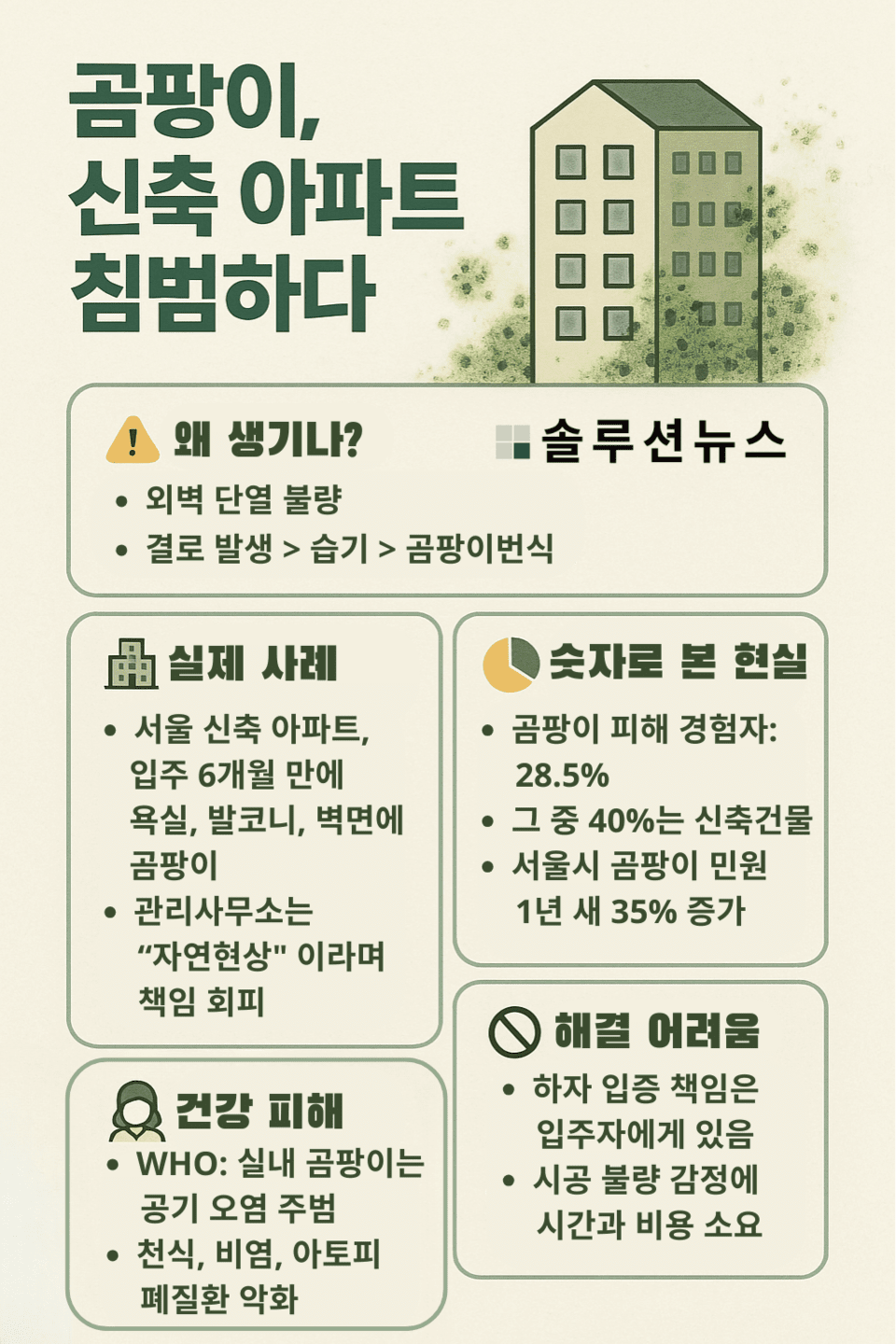What has grown on the walls of urban apartments is not art, but mold. Even newly constructed residential areas in the city cannot prevent the intrusion of mold.
The residents of a new apartment in Seoul had to battle with mold that was invisible all winter. Just six months after moving in, mold began to spread in bathrooms, balconies, and walls, but the management office brushed it off as a “natural phenomenon due to winter condensation.” The real issue, however, was a flaw in the design. The exterior wall insulation was not properly done, leading to continuous condensation from the indoor-outdoor temperature difference, which became the primary cause of mold proliferation.
According to the Korea Institute of Civil Engineering and Building Technology, more than 60% of mold problems in new buildings originate from poor exterior wall insulation and inadequate condensation prevention design. A residential environment survey published by the Ministry of Land, Infrastructure, and Transport in 2023 also reported that 28.5% of respondents experienced indoor mold issues, with over 40% occurring in buildings less than five years old.

The conditions for mold growth are clear: humidity above 60%, a temperature between 20 to 30 degrees Celsius, and poorly ventilated dark spaces. In such environments, any construction material can become a host for mold, including wood, textiles, silicone, and even concrete.
Mold issues were traditionally thought to occur mainly in old houses, but they are now more frequently reported in new apartments and offices. In 2024, mold-related complaints at the Seoul Joint Housing Defect Reporting Center increased by 35% in a year. This was particularly prevalent in new urban residential complexes on the outskirts of the metropolitan area, identified as a result of rapid construction and poor insulation during mass building projects.
Korean building standards are insufficient in structurally preventing potential mold occurrence. Although the current ‘Building Energy Saving Design Criteria’ mentions insulation performance and condensation prevention, the current system lacks thorough verification during construction and inspection processes. Even when mold is identified, determining it as a structural defect requires evaluation by external experts and detailed investigation, with the burden of proof lying with the residents.
Moreover, mold spreads over time, severely compromising the functionality of the living spaces if not addressed promptly. In some cases, mold can cause wall finish coatings to peel or internal wooden structures to rot. Mold spores dispersed in the air also affect the health of residents, but recognizing them as a legal defect involves lengthy administrative procedures.
Mold is not merely an issue of smudging walls. The World Health Organization (WHO) identifies mold as one of the major causes of indoor air pollution. Prolonged exposure to indoor mold exacerbates respiratory diseases such as asthma, rhinitis, and bronchitis. A 2022 report by the Korea Disease Control and Prevention Agency found that four out of ten domestic atopic dermatitis patients experienced skin problems due to mold.
Particularly concerning is mold such as Aspergillus, which can cause severe infections like pneumonia and can be fatal to individuals with weakened immune systems, like the elderly, infants, or cancer patients. The Ministry of Environment announced in 2023 that cases where indoor air quality deterioration due to mold directly leads to health problems are rising. A study conducted by a university hospital research team indicated that people living in moldy indoors had more than a 30% higher rate of reduced lung function compared to the general household.

The main key to preventing mold is one: humidity control. Keeping indoor humidity at 40-60% is paramount. Moisture-prone areas like bathrooms and kitchens should be ventilated immediately after use, and dehumidifiers should be installed in places prone to condensation. Additionally, leaving space between walls and furniture, regular cleaning, and checking for leaks are important. If mold has already appeared, use removers like bleach or hydrogen peroxide, but ventilation and protective equipment use are mandatory.
There are growing calls for government-level mold prevention policies. The U.S. Environmental Protection Agency (EPA) suggests indoor mold management guidelines regarding standard humidity, ventilation, and mold detection and removal manuals, with legislations enacted in many states. Similar effective regulations and response manuals are needed domestically.
Mold transcends mere lifestyle inconvenience, presenting a complex issue including structural defects and health risks. It has already deeply penetrated numerous households. Combating mold is no longer sustainable with reactive approaches alone; prevention is key. Managing indoor humidity, preventing condensation, and designing for ventilation are the minimum requirements for a mold-free living environment. When routine checks and preventative measures accumulate, the battle against this invisible invader eventually restores balance.